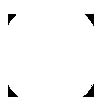

Peripheral darkening (vignetting) in microscopy and macroscopy photography
Vignetting in micro or macrophotography is peripheral darkening at the edge of the image. This effect can be either desirable or undesirable depending on the field of application.
Vignetting is categorised according to different degrees of severity:
 |
 |
 |
| weak | moderate | severe |
In addition, the symmetry of the vignetting is also judged. An asymmetrical appearance to the vignetting ring is the first indicator that the optical system is not correctly centred. Mostly the camera unit is not positioned perfectly over the microscope’s optical axis. In rare cases, the camera's sensor chip is not correctly positioned inside the camera body.In normal photography, these production tolerances mostly go unnoticed. However, when used in conjunction with a microscope, all mechanical irregularities and image distortions in the parallel light path are very much intensified.
Centric and non-centric position of the vignetting ring:
 |
 |
| centric position | non-centric position |
Workaround: If it is not possible to adjust the optical system so that it is precisely centred, then with cameras with in-built zoom lenses it is possible to zoom in to the image until the vignetting and misalignment disappear. The image quality is not disadvantaged by this approach, as in the process any image section within the vignetting is enlarged to a full format image.
Depending on the field of application, vignetting may be acceptable. In the case of gastroscopic or endoscopic photography in medical use, 100% of the round image must be reproduced on the rectangular camera sensor. The doctor needs to view 100% of the information on the image transmitted through the fibre optics, and will therefore accept vignetting and blurring around the edges of the ring.
In microscopy, more importance is placed on achieving a full format, rectangular reproduction of the field of view than on achieving a circular reproduction of the field of view that is true to the original. The camera sensor should be illuminated in such a way that there is no possibility of vignetting. With this optical adjustment, the camera’s pixel count can be utilised to the optimum.
What actually causes vignetting?
The majority of optical elements such as lens elements, apertures, tubes and lens units are manufactured as round elements. Only the camera sensor is made as a rectangular electronic component. Vignetting is therefore the reproduction of the optical edge of the microscope’s light path. By reproducing the round microscope image on the rectangular camera sensor, all of the areas of the image lying outside of the round microscope image remain unlit and thus black.
Only with greater magnification of the round microscope image is the rectangular camera sensor exposed to light in such a way that the image is illuminated over the entire sensor area without peripheral darkening (vignetting).
If high image quality is important to you, then optical adjustment between the microscope and the camera is indispensable. The LM digital adapter ensures that the image is projected onto the camera chip at the optimum size. Furthermore, the microscope’s chromatic image distortions must be compensated for. As a result of the interaction between the optical limit and the light, there are considerably more serious image distortions on the edges than in the middle of the optical axis. If the adapter does not fulfil its function to the optimum, then there will be flaws in the reproduction (chromatic and spherical aberrations) and vignetting. An optimum adjustment between the microscope and the camera is only possible if the camera’s lens can be removed.
The camera lens unit with its many optical elements (up to 19 lens elements and more in the case of zoom lens units) only has the effect of reducing quality in the microscopic light path and is not needed in microphotography. For this reason, digital SLR cameras and professional camcorders are equipped with interchangeable lens mountings.
In this case, the microscope adapter is directly connected to the camera body via the bayonet mount.
The most common causes of vignetting in microphotography and macrophotography:
- Optical axis of camera and microscope not in line
- Camera lens limits the light path
- No optical adjustment between the microscope and the camera
- An unsuitable projection lens is already integrated in the microscope’s photo tube or C-mount connection
- The optical system is off-centre
Compact cameras and camcorders on the microscope
DSLR cameras are simply better!
Caution! This manual is protected by copyright. Unauthorised reproduction thereof, in whole or in part, is punishable by law. Only use with MICRO TECH LAB’s approval.
New LM Digital Adapter for: Sony Alpha 9 III / Nikon Z9 / Nikon Z8 / Sony Alpha 7R V / Sony Alpha 1 II / Sony Alpha 1 / Sony Alpha 9 II (ILCE-9M2) / Sony FX3 Cinema Line / Sony Alpha 9 / Nikon D6 / Canon EOS R3 / Canon EOS R6 Mark II / Canon EOS R8 / Sony Alpha 7R IV / Canon EOS R5 II / Nikon Z6III / Canon EOS R5 / Sony Alpha 7S II / Sony Alpha 7S III / Sony Alpha 7R III / Canon EOS R6 / Nikon Z6 / Nikon Z6II / Sony Alpha 7R II / Nikon Z7 / Nikon Z7II / Canon EOS R / Canon EOS Ra (Astro) / Nikon Z5 / Sony Alpha 7C / Canon EOS RP / Sony Alpha 7S / Canon EOS R7 / Leica SL2-S / Canon EOS R10 / Nikon Z50 II / Canon EOS 1D X Mark III / Nikon Z50 / Nikon Z30 / Nikon Z fc / Nikon D850 /
